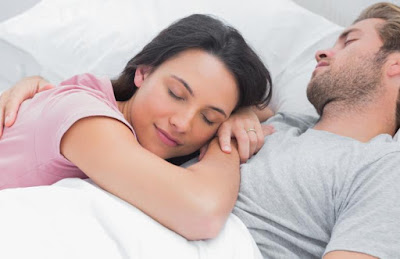Our spines secretly hate us. One-third of people in the US suffer from some form of back pain. That number is expected to greatly increase over the next few years, thanks to a combination of the desk-bound life and our generally inactive society. Night should seemingly bring relief, but the discomfort doesn’t lessen when we lie down.
“People have more pain at night and in the morning because their joints aren’t moving,” says Joseph McNamara, a chiropractic neurologist in Cumming, Georgia. “The brain doesn’t send extra blood flow to the area.”
In addition to strain and lack of movement, back pain is caused by such conditions as scoliosis (a curvature of the spine), arthritis, spondylitis (inflammation of the joints along the spine), bulging or ruptured discs and osteoporosis.
Due to the variety of back issues, there’s no one-size-fits-all answer for how to
If You’re a Stomach
Sleeping on your stomach is generally regarded as the worst
“It’s like you’re looking over your shoulder for 8 hours,” because your head needs to be twisted to one side or the other to enable you to breathe, says Dr. Ariel Blackburn, a chiropractor on Johns Island in South Carolina,
It also hyperextends the spine, which can exacerbate low back pain.
Those tight muscles then make the low back arch more, says Dr. Joseph Horrigan director of the Soft Tissue Center at DISC Sports & Spine Center
“As the arch increases, the joints of the spine (facet joints) become compressed. If these joints are already irritated or inflamed, the person can wake up with a dull, low backache,” he says.
Stomach sleeping can be so detrimental, in fact, that many doctors recommend that patients try getting used to sleeping on their sides instead.
But if you find it too difficult to fall asleep in any other position than your stomach, rotating slightly to the side and using a thin pillow could alleviate the discomfort, says Dr. Kamshad Raiszadeh, a board-certified orthopedic surgeon and co-founder of SpineZone in California.
If You’re a Back Sleeper
When you lay flat on your back, the position can put too much stress on the lower discs because you’re flattening out the lumbar lordosis (the natural forward curve of your low back), explains Matt Tanneberg a sports chiropractor and certified strength and conditioning Specialist in Phoenix.
Propping a pillow under you knees, however, promotes the normal curve of the lumbar spine and allows the low back to relax.
As for your head, don’t be afraid to be primadonna-particular about the pillow you
The pillow shouldn’t be fatter than the distance from your neck to your shoulder, advises Blackburn. Back-sleepers can exacerbate their pain if their heads are propped up too far forward, which creates increased neck flexion.
“If you
And that thinner pillow doesn’t necessarily have to be pricey to be therapeutic. “A small rolled-up towel or half-moon pillow under the neck can also be helpful in maintaining normal neck posture,” Raiszadeh adds.
If you want to try a special therapy pillow, McNamara recommends the cervical variety, as it “helps support the lordotic curve of the neck when you’re lying on your back and keeps the spine straight when lying on your side.”
A foam wedge under your knees might also be good idea to prevent excessive lumbar lordosis.
“Foam wedges are often preferable to pillows since pillows flatten and shift,” Raiszadeh says.
A pillow under the knees is also the best way to
The pillow-propped position is also great if you have an anteriorly rotated pelvis, adds Raiszadeh.
If You’re a Side-Sleeper
Every pregnant woman learns to
Pillow choice and placement are crucial though. The pillow should be small enough to not feel awkward between your legs, yet big enough to keep you from rolling onto your back or stomach.
If you
It should be noted, however, that some of the pillow products meant to help people with back pain
“A person who’s mostly a side-sleeper may not do well with a contoured pillow because the contoured portion could actually cause his or her neck to be pushed out of its natural alignment,” Blackburn says. “And memory pillows are very dense and can take a patient a while to get used to. Or they might be too large, which can force their necks into flexion when they’re on their backs.”
To increase your chances of a good night’s sleep no matter what
“If you’re a chronic back pain sufferer, use heat. It will relax the low back muscles and take away some of the tension,” says Tanneberg (If you have an acute back injury, however, use ice. Heat will increase the inflammation and make your pain worse.)
Mike Chang,Sales Manager
Website:
Mb: +86 170 9015 0981 | mike@bjmmf.com | Skype: mike_newin
Other Articles about mattress you may have interest:
Top Eight Tips for More Wonderful Night's Sleep
Top eight sleeping habits to help you sleep better
How to Buy a Mattress
How to Sleep Comfortably in Any Position
How to Pick Your Perfect Mattress
How the Mattresses You Sleep on Actually Affects You
The more Money I pay, the better mattress I get?
3 Signs Your Mattress Is Too Soft
Buy a Better Mattress With These 6 Smart Tips
Top 4 Things You Should Know Before Buying a New Mattress
Secrets of the Mattress Industry, How to Save Shipping Cost in Mattress Industry
Top 3 Smart Shopping Tips for Getting Better Sleep Mattress
Secrets of the Mattress Industry, How to Save Shipping Cost in Mattress Business?
Top 4 Tips for Buying a New Mattress
Will My Bed Mattress With Different Mattress Spring Systems Sink Down Heavily After Years ?
Secrets of the Mattress Industry, How to Save Shipping Cost in Mattress Business?
How to shop for a bed mattress online
Can Famous B2B Paid Golden Membership Really Secure Your Business and Money?
What shoould we Look for When Buying Mattresses
Is Coir mattress good or bad?
You think you really know about your bed mattresses ?
Do Brands really tell the quality of the products you buy?
Get Rid Of Sleepless Nights From Back Pain
How to Choose yourself a right mattress?
How to lower the possibilities of being cheated in business?
Are you still suffering from bad after-sale services?
The advantages of 100% Natural Latex Mattresses
Factors you need to consider when buying a mattress
How to define whether you are buying a brand-new mattress?
Why Latex Foam is better than Memory Foam or Gel Memory Foam ?
How to select Best Mattresses for Yourself or Family Members ?
How long can a mattresses support your sleep ?







